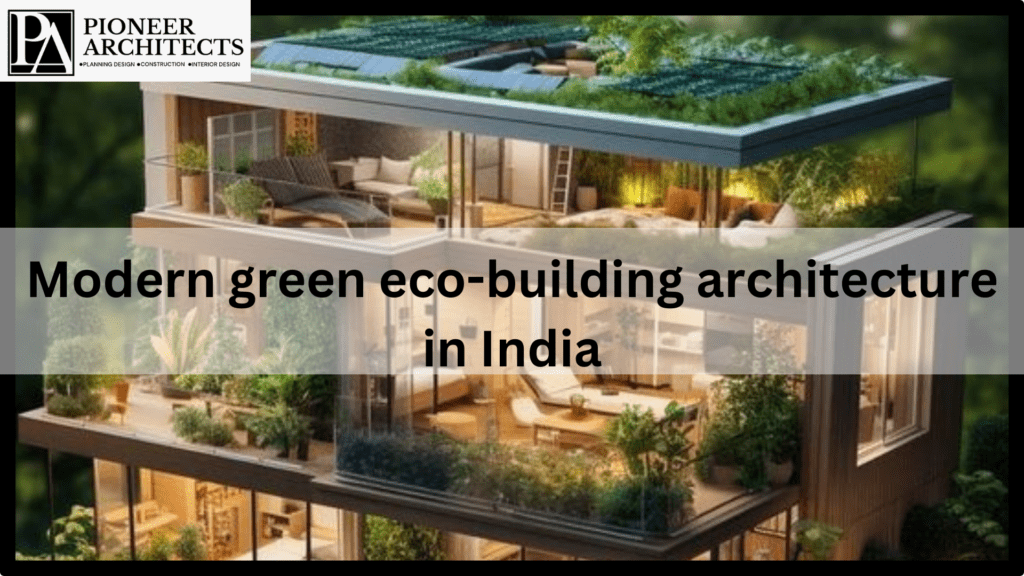Modern green eco-building architecture in India

Introduction:
India, a country known for its rich cultural heritage and diverse landscapes, is making significant strides in the realm of modern green eco-building architecture. As the world grapples with environmental challenges, the architectural landscape in India is witnessing a paradigm shift towards sustainable and eco-friendly designs. This article explores the evolution of modern green eco-building architecture in India, the key principles guiding eco-building designs, and showcases some exemplary projects that embody these principles.
Historical Perspective:
The concept of sustainable architecture in India traces its roots to traditional building practices that were inherently environmentally conscious. Ancient structures like step wells, courtyards, and vernacular houses were designed with a deep understanding of local climate, materials, and energy efficiency. However, the advent of modernization and urbanization led to a departure from these principles.
Emergence of Green Architecture:
The need for sustainable practices gained prominence in the late 20th century, prompting architects to reevaluate their approach. The integration of green building concepts, such as energy efficiency, water conservation, and the use of renewable materials, began to take center stage. India witnessed the emergence of rating systems like GRIHA (Green Rating for Integrated Habitat Assessment), which provided a framework for evaluating the environmental performance of buildings.
Key Principles of Eco-Building Architecture:
- Energy Efficiency: Modern green buildings in India prioritize energy-efficient designs, incorporating features like solar panels, natural ventilation, and energy-efficient lighting systems. These initiatives reduce the carbon footprint of structures and contribute to long-term sustainability.
- Water Conservation: Given India’s diverse climate, water conservation is a crucial aspect of eco-building design. Rainwater harvesting, wastewater treatment, and efficient plumbing systems are integrated into green buildings to minimize water usage and promote responsible water management.
- Use of Sustainable Materials: Architects are increasingly turning towards locally sourced, recycled, or renewable materials. This not only reduces the environmental impact of construction but also supports local economies. Bamboo, recycled steel, and environmentally friendly concrete alternatives are gaining popularity in green architecture.
- Biodiversity and Green Spaces: Integrating green spaces within and around buildings is a hallmark of eco-friendly design. Rooftop gardens, vertical green walls, and landscaping not only enhance the aesthetic appeal but also contribute to biodiversity and overall well-being.
- Waste Management: Minimizing construction and operational waste is a priority in green architecture. Innovative waste management strategies, such as recycling and reusing construction materials, contribute to reducing the ecological impact of building projects.
Exemplary Green Building Projects in India:
- Infosys Limited, Mysuru Campus: The Infosys Mysuru campus is a shining example of sustainable architecture. Designed with a focus on energy efficiency, the campus incorporates solar panels, rainwater harvesting, and a comprehensive waste management system. The use of locally sourced materials and green landscaping further enhances its environmental credentials.
- IIT Kanpur’s Center for Environmental Science and Engineering: This academic building showcases a commitment to sustainability. The design incorporates passive cooling techniques, energy-efficient lighting, and rainwater harvesting. The use of recycled materials and a thoughtful layout contribute to a reduced environmental impact.
- Suzlon One Earth, Pune: Suzlon One Earth stands out as a green corporate office complex. It boasts features like wind turbines for on-site power generation, extensive green roofs, and water-efficient landscaping. The design prioritizes employee well-being by maximizing natural light and ventilation.
- The Pavilion, Dharwad: This residential project in Karnataka exemplifies sustainable living. The Pavilion integrates solar energy, rainwater harvesting, and a green roof design to enhance energy efficiency and minimize environmental impact. Its thoughtful architecture prioritizes both aesthetics and functionality.
Challenges and Future Prospects:
While the green building movement in India has made significant progress, it faces challenges such as the initial cost of sustainable technologies, awareness among stakeholders, and the need for supportive government policies. However, increasing awareness about environmental issues, coupled with a growing emphasis on corporate social responsibility, is driving the demand for green buildings.
The future of eco-building architecture in India holds promise. Continued research and innovation in sustainable technologies, collaborations between architects and environmental experts, and the implementation of stringent green building standards will contribute to a more sustainable built environment.
Conclusion:
Modern green eco-building architecture in India represents a fusion of traditional wisdom and contemporary innovation. Architects and builders are embracing sustainable practices to create structures that not only minimize their impact on the environment but also contribute to the well-being of occupants. As the nation continues to urbanize, the importance of green architecture cannot be overstated. It is a beacon of hope for a future where buildings seamlessly integrate with nature, setting a new standard for construction practices worldwide.





